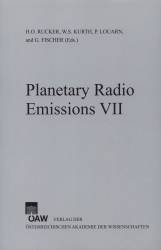
Planetary Radio Emissions VII, pp. 261-268, 2011/12/28
Proceedings of the 7th International Workshop on Planetary, Solar and Heliospheric Radio Emissions held at Graz, Austria, September 15–17, 2010

Interball-2 (Auroral Probe) Polrad triaxial spectropolarimeter was used to determine positions of AKR source footprints on the auroral oval. Our findings are consistent with AKR beams narrowly confined to a plane tangent to the source magnetic latitude circle and containing the local magnetic field vector, in agreement with Mutel et al. [2008]. Our approach is based on dynamic spectra data analysis on much longer time scale of two-minute moving averages, as compared to AKR microbursts tens of milliseconds long analyzed by Mutel et al. We show detailed AKR visibility maps for a given position of the spacecraft - that allow determination of both the azimuth and elevation of the AKR beam in question for every measured AKR source position. For long data runs of the order of one hour we see apparent motion of the AKR sources as measured by Polrad, following spacecraft motion along the orbit in such a way, that the spacecraft remains within the radiation beam obeying geometric constraints reported by Mutel et al.